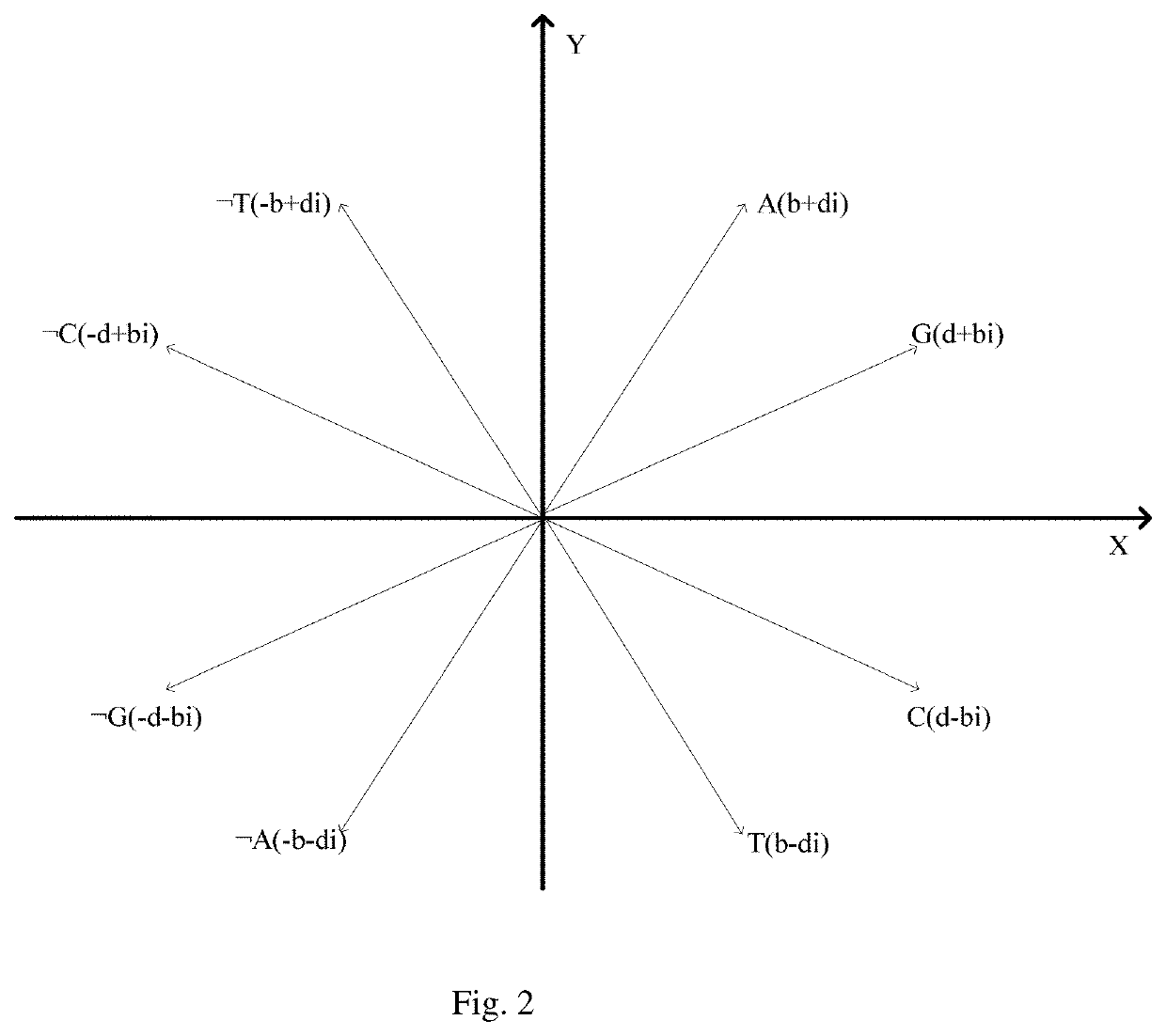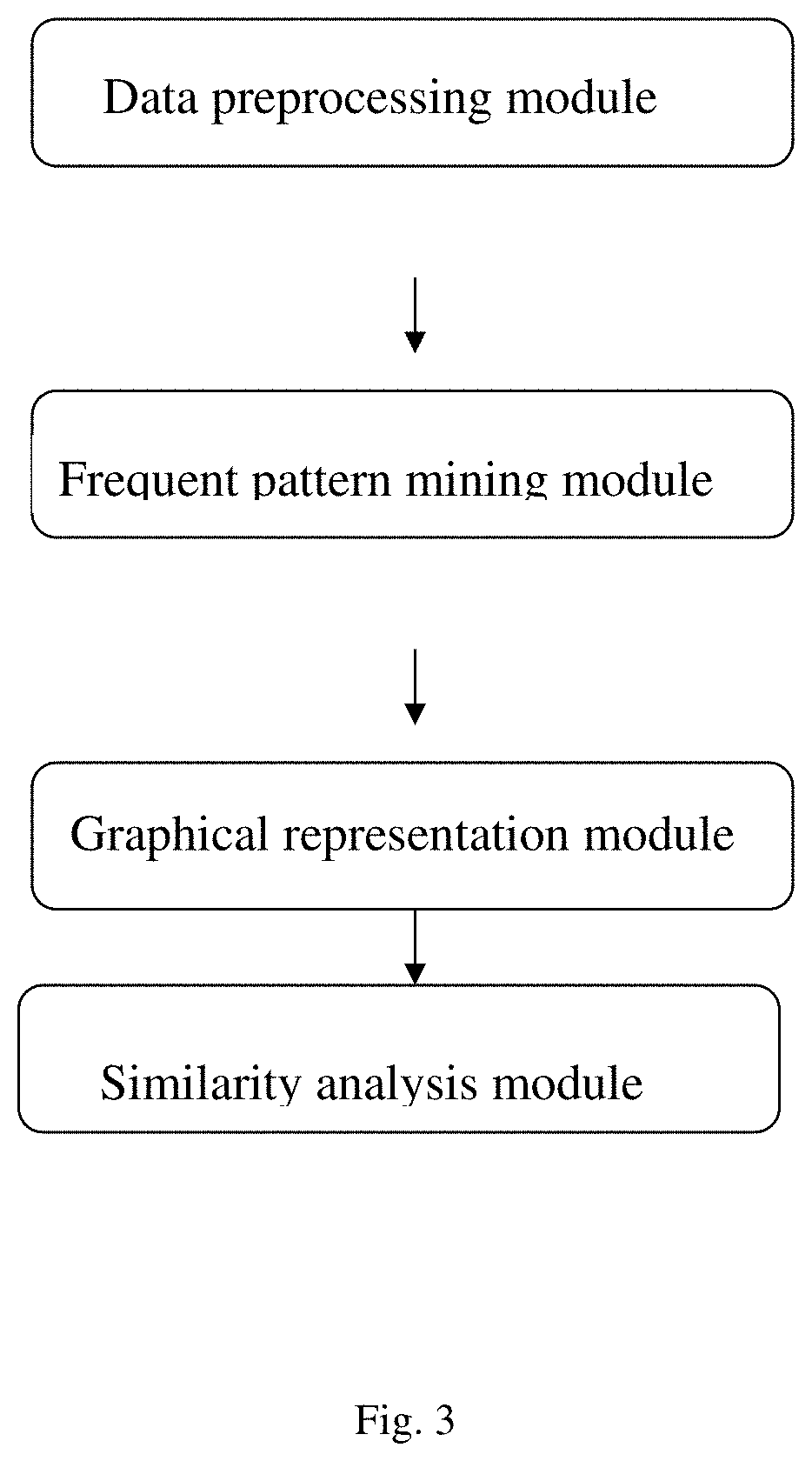Similarity analysis method of negative sequential patterns based on biological sequences and its implementation system and medium
a similarity analysis and biological sequence technology, applied in the field of similarity analysis of negative sequential patterns based on biological sequences and its implementation system and medium, can solve problems such as gap penalties, affecting similarity scores, and lack of uniform similarity measurement methods for nsps
- Summary
- Abstract
- Description
- Claims
- Application Information
AI Technical Summary
Benefits of technology
Problems solved by technology
Method used
Image
Examples
embodiment 1
[0064]A similarity analysis method of negative sequential patterns based on biological sequences, as shown in FIG. 1, which comprises steps as follows:
[0065](1) Data preprocessing
[0066]Each sequence or genome to be processed must be preprocessed prior to frequent pattern mining. The specific process is as follows: represent the letters in the DNA sequence with numbers; as the DNA sequence is very long, divide the sequence represented by numbers into several blocks each with the same number of bases, and the several blocks obtained shall be used as datasets for frequent pattern mining;
[0067]In the present invention, each sequence is first divided into several blocks, with each block consisting of the same number of continuous bases. The blocks are independent of each other, and the size of the blocks can be changed in practice. However, one thing needing to be noted is that if the size of the last block is smaller than that of the specified block, the block will be discarded. For cla...
embodiment 2
[0076]A similarity analysis method of negative sequential patterns based on biological sequences according to Embodiment 1, provided however that:
[0077]The mining of the dataset D with the f-NSP algorithm in Step (2) comprises steps as follows:[0078]A. Obtain all positive frequent sequences with the GSP algorithm and store the bitmap corresponding to each positive frequent sequence in the hash table, including:[0079]a. Storing all sequence patterns with a length of 1 obtained by scanning the dataset in the original seed set P1;[0080]b. Obtain sequence patterns with a length of 1 from the original seed set P1 and generate a set C2 of candidate sequences with a length of 2 through join operations; prune the candidate sequence set C2 by using the Apriori's character and determine the support of the remaining sequences through scanning the candidate sequence set C2; store the sequence patterns with support being larger than the minimum support, and output them as sequence pattern L2 wit...
embodiment 3
1. Embodiment 3
[0091]A similarity analysis method of negative sequential patterns based on biological sequences according to Embodiment 1, provided however that:
[0092]The graphical representation of the maximum frequent positive and negative sequential patterns in Step (3) include: constructing a Purine Pyrimidine Graph on the complex plane with first and second quadrants representing the purines, including A, ¬A, G, and ¬G, and the third and fourth quadrants representing pyrimidines, including T, ¬T, C, and ¬C. The four nucleotides A, G, T, and C and their corresponding negative sequence unit vectors ¬A, ¬G, ¬T, and ¬C are as shown in equations (I) to (VIII):
(b+di)→A (I)
(d+bi)→G (II)
(b−di)→T (III)
(d−bi)→C (IV)
(−b−di)→¬A (V)
(−d−bi)→¬G (VI)
(−b+di)→¬T (VII)
(−d+bi)→¬C (VIII)
[0093]Where: b and d are non-zero real numbers and
b=12andd=32;
A and T are conjugate and G and C are also conjugate, namely Ā=T and C=G. A, T, C, and G represent the actually existing base pairs while ¬A,...
PUM
 Login to View More
Login to View More Abstract
Description
Claims
Application Information
 Login to View More
Login to View More - R&D
- Intellectual Property
- Life Sciences
- Materials
- Tech Scout
- Unparalleled Data Quality
- Higher Quality Content
- 60% Fewer Hallucinations
Browse by: Latest US Patents, China's latest patents, Technical Efficacy Thesaurus, Application Domain, Technology Topic, Popular Technical Reports.
© 2025 PatSnap. All rights reserved.Legal|Privacy policy|Modern Slavery Act Transparency Statement|Sitemap|About US| Contact US: help@patsnap.com



